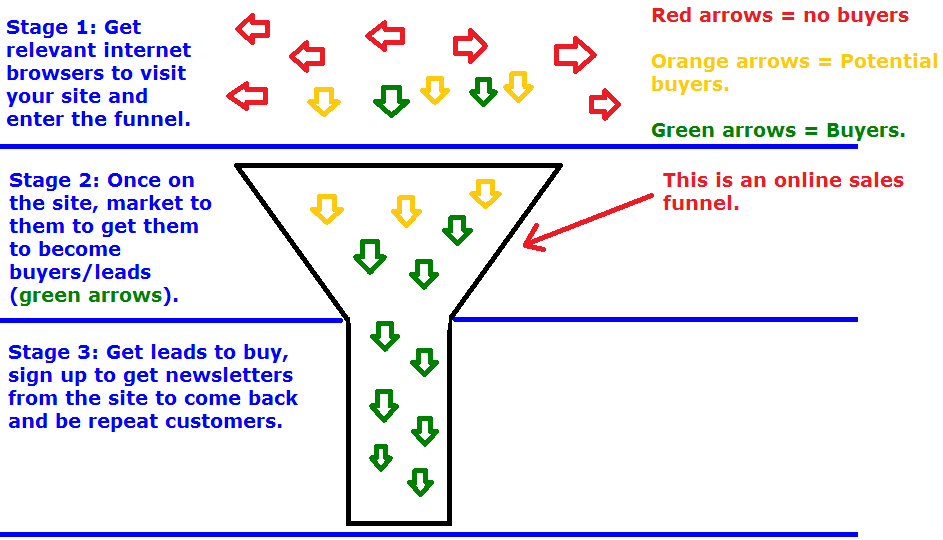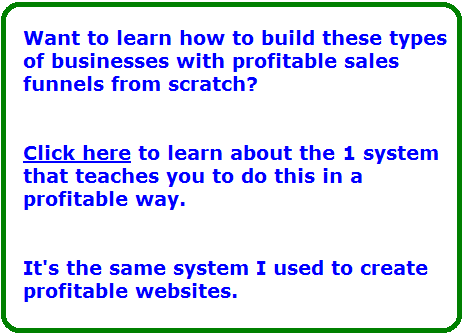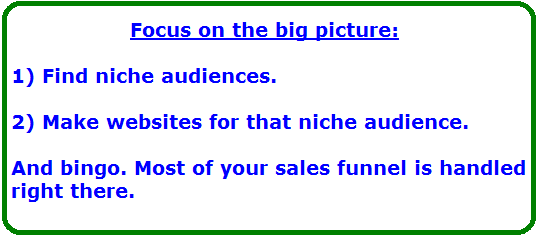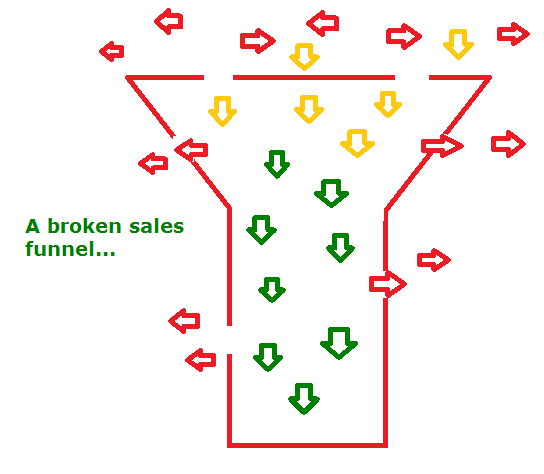To become a better, more profitable business owner, one needs to understand how sales funnels work, what they really are and how to truly use them to their full extent.
Although the specific one we’re talking about in this article is the online one, I assure you, whether you run a website or a physical business, what you read here and take action from will absolutely help your profits grow.
That being said…
What are sales funnels in general?
Have you ever taken a large cup of any liquid and tried to pour it into a bottle?
How do you ensure that the liquid doesn’t leak out?
Simple, you use a funnel. That’s where this idea originated for businesses.
Think of that image for a moment and then change the terms to this:
- Liquid = customers.
- Bottle = your business.
- Funnel = the tool/s you use to get customers to your business.
Let’s take a physical business, say a pet store. It is located on a busy street where lots of people cross through everyday. Obviously to make money, the store owner would have to get those people to come in right? How does the business do that?
Well it could advertise cute animal pictures, discounts in large banners outside the store, and this will hopefully get people to notice it. Typically these things get attention. You can call those the tools.
Then when a portion of the people passing by enter, then the next stage is to get those people to buy things. The store could advertise different coupons on products for different animals, maybe put up the most highly purchased products, and again just do things to capture the people who are already inside the store to look and buy.
All of these things the owner/s does to get the visitors from the street into the store and then to buy things is a perfect example of a sales funnel and the different stages of it.
Here is what a sales funnel looks like:
This illustration really shows how the whole process works. If we apply the 3 stages to the pet store example I made, then here’s what we have:
Stage 1:
Out of the people who pass by the store, most of them are red arrows. They may not be interested in pets, but the job is to put up advertisements and anything to get those arrows to turn and enter the funnel (store).
Stage 2:
Once inside, you can consider those arrows to turn orange. Now the store has to make the people in the store from orange into green arrows (buyers) via the things we talked about like coupons, sales, ect…
Stage 3:
Once they are green, the sale is almost certain, then it’s the job to keep them coming back.
Overall, through the 3 stages, we have an entire sales funnel set up and get people to come into the business and become a customer. And the way they “funnel” through this process is through different tactics (marketing tactics) the owner uses to get their attention.
Does this idea change when we talk about online businesses?
Not really, the big picture is still the same, but the terminology is a bit different:
Liquid = internet traffic, which would be considered customers in the offline world. In this case, search engine and social media browsers. That really makes up for a large majority of the people who browse the internet.
Bottle = your website which would originally be considered the store. The more liquid you can get into the bottle without spilling, the more you can make.
Funnel = in this case, it would any online marketing tactics you use to get that liquid (internet traffic) to your site and then have the people on the site do things like opt in to receive emails, buy things and be returning customers.
But let’s take this online version of it and use the same type of image we did above.
This is what an online sales funnel looks like:
That is a simplified examples of an ONLINE funnel. Let me give you some specific examples of how these actually operate when executed properly:
Examples of actual online sales funnels:
Example 1:
A person has a website about beagles (dogs) and how to care for them. I used beagles as an example because this is a niche.
He attempts to attract beagle owners, so he writes articles on his website talking about caring for this breed. The articles get ranked on Google, attract actual beagle owners and beagle lovers to the site.
The person who runs the site then sells items to those people visiting such as books on caring for them, collars and other accessories.
The sales funnel here is that the website owner correctly picks a specific topic to build his business on and attract the specific audience that would be perfect to sell those items to. Why wouldn’t beagle owners for example want to get a book on taking care of their beagle?
Example 2:
A person creates an ad talking about making money on the internet. They then advertise the ad on Bing and Google, attract people looking to make money to their website which says if they sign up, they’ll send them a free book and/or show them how things work.
The process by which the person advertises to a specific audiences and gets them to click on the ad, go to the site and then sign up or BUY the product they are selling is also a sales funnel.
Example 3:
A person has a website on fitness tips, goes to social media, and starts running ads for people who are also (based on likes) fans of getting into shape. The ad runs, attracts the right audience, they visit the site and the person can then sell tips on fitness and sell plenty of information on it as well as fitness accessories.
The most important thing to notice in each example:
There is always a specific website/products being sold to the specific, relevant audience. You absolutely need to understand this because it is a key factor in success.
One of the things that makes online businesses and the marketing they use to get customers superior to the ones physical businesses use is that your business is MOBILE, and not in the phone sense, but in the sense that ANYONE in the world can type in a search phrase they seek and be shown your site, thereby making your entire range of audiences/customers worldwide.
Whereas a physical business is stuck in one location and needs to essentially get lucky by having people pass by their store to walk in.
Not only is that tougher for the offline business, but think about all the people who walk through who aren’t interested in what the store sells.
This happens all the time and contrary to that, if you have a website which has a specific audience in mind it seeks to attract (the best is a laser audience), like with the examples above, and you use the right sales funnel to attract them, you will ALWAYS get that specific audience.
This means in the long run, you are always attracting actual customers who are at least warm enough to visit your site. You will make more money in the process. And speaking of warmth, I have an article about this idea that the warmer your audience is that visits you page, and by that I mean more relevant, the better your sales will be.
For those of you who read my site often (thank you!), you will know I preach constantly about niche markets. Well that’s another term for specific audiences. In each example above, I listed a niche audience and making a website for the specific audience, in order for it to succeed.
I would rather not re-explain everything on niches, because I’ve written countless articles on this and here is the most important one if you’re unfamiliar with this term. Know that if you understand niches and how they lead to a better, more successful business, you will be that much closer to creating a smart sales funnel that earns you more money.
A warning on how sales funnels can be meticulous, confusing, but necessary:
I am about to give you some examples which may have you think that these things are so confusing that it’s not worth trying, but even if that happens, I want you know that even if you don’t understand the example I’m about to explain that the basic understanding of niches in my opinion is the MOST important factor that already puts you on the road to having that profitable sales funnel.
Now here comes the meticulous part…
Know that sales funnels, especially when dealing with online ones can be very intricate. Let me explain:
Let’s say I use one of the examples above, the last one on fitness. Let’s assume I am the one who makes the website and decides to run ads on social media platforms…
But in letting this idea run for about a week, I see that not a lot of people are joining or buying anything. What’s going on?
Well perhaps it’s my ad, perhaps it’s my site, perhaps it’s the people I’m attracting or perhaps it can even be the whole marketing approach that is causing the lack of profit to happen.
Or as this picture shows, there’s something broken within this process and I need to identify what it is, fix it and it may require some major changes…
These things happen ALL the time to anyone who runs an online business and when they do, the important thing to do is to TEST different approaches to see how they affect the business. In the case here, perhaps I can do the following:
- I can start trying to get traffic from Bing and Google, and not just social media.
- Perhaps I can change the images on my ads or the wording of my ad to see if it gets more clicks.
- Perhaps I can re-analyze if the traffic I am getting to the site is relevant enough and if it isn’t to update my marketing methods to make sure I get the right audience (the fitness one) to the page.
- Perhaps on the page the audience lands on, I can do things like change and add pictures of healthy, fit people to see which ones affect the stay times of the people who land on the site and if I see that they stay longer, that’s a good sign they may buy.
- Maybe I can experiment with adding an opt in form and sending people a free guide on fitness.
These are just 5 different examples of things I can do if my existing business model isn’t as successful as I’d like it to be and even if it is, this testing will clear up if I can make it more successful or not. These experiments are necessary in ANY online business that exists because it helps you become a more knowledgeable and profitable internet marketer and when you engage in future online businesses and create sales funnels for those, you will have pre-existing experience to help you get it right and make it profitable initially.
Now if you don’t understand those 5 examples I talked about, don’t worry, their purpose wasn’t to do that, it was just see that as you become an internet marketer and attempt to make your website/s profitable, these are just some of the experiments and tests you can run.
The idea is to keep testing different angles and re-arranging your overall sales funnel to see which version provides the best results and those 5 examples are just some of the many that are possible. Here’s another example of how to build successful sales funnels.
I listed an entire case study on how I re-arranged a particular site I have and how it made me make more money and in that case study, I go into deep details on what specific things I added and changed and how it affected the performance of the page and profits.
With all the potential ways that are possible in the online world to create profitable websites, I have found that if you stick to the main idea of niches, relevant sites and offers, you will already be on the right track to make the website work. In spite of all the plethora of tests you can run, there are some golden, central ideas that will generally always get a positive, profitable result.







There’s a lot to take on board here but I do like the way you’ve explained the differences between the online and offline sales funnels.
Do you have any thoughts on what the most effective methods are for funneling as I’ve heard so may conflicting ideas about this, it’s difficult to know which is most accurate?
You honestly have to test which sales funnel best fits your site Dave. It’s not an answer you’ll immediately get and often it depends not just on the testing aspect, but also on the niche topic.
Generally, sites which teach about making money tend to use the opt-in form of sales funnels. It’s not wrong, but it’s also not the best as I personally use a regular affiliate marketing funnel and I find it perfectly suitable to me.
Focus on getting traffic to your site in masses first, and trying out 1 form of selling, which could be affiliate marketing. See how that does for your profits, then change your funnel around and link all content to an opt-in page, collect an email list, then sell that list something and see how it works.
You’ll have 2 experiments to test out through this and will be able to see which one performed better and then decide if a third experiment is warrant or if you need to stick to the current one, or go back to the other one. So the short answer to your question is that there’s no such thing as a “best” sales funnel, it has to be a FLEXIBLE one.
Nice! I kind of had the wrong idea of what a sales funnel was. After reading the article I have a better understanding of it. I do not have a sign up form on my site. I think it would be a good idea to put one up and start making more money. You made it so simple and I can not simply leave money on the table. I appreciate the article, it was great.
Remember, sales funnels are not just limited to opt in forms Kendrick, it is just a representation of how your traffic flows from the moment it lands on your site to the moment it does something like buy from the site or signing up for something on the page.
I really like how you used a diagram to thoroughly explain the idea of a sales funnel. It makes it a lot easier to visualize and really get the whole concept. For anyone that is new to marketing online, this should help them get the basics down very quickly. Thank you for this great article!
No problem Jade, do know that while the structure of the funnel is always the same, the strategies you use can absolutely be different for how you turn traffic into sales.
I heard the term sales funnel but was never 100% sure what it meant, however, after reading this, I have a good understanding of it now. I think the bottle with arrows gives it a decent understanding.
I am currently just adding content to my site with a bit of sharing on social media but I am also thinking about building an email list. I am just not sure if I should do that right away or if I should wait a bit longer when I have a bigger following.
My question is, would you recommend that I create an opt in email newsletter for my site if I have not made my first sale yet or should I try and do that first?
Also, what would you recommend me doing other than posting consistency to get that first sale?
Target your keywords the right way Arie, and post based on the keywords you find with low competition, that is the best tip I can give for your last question.
As for your question on building an email list, none of this makes sense until your website actually gets hits/traffic. I would wait until that moment (post new content until then), and then when you have real traffic coming to your site on a daily basis, then add an opt-in (or whatever sales funnel you wish to go with).
Great article. A good way to describe the funnel channel through the painting. I like your examples. I am going to start using different pictures for my ads, I think that is affecting my traffic, so thanks for the advice. Also, what about using YouTube as a funnel? I guess you can upload videos with a link?
I don’t know what ad options you are using, but my examples come from traditional ads you put up on search engines and they only have the option to use text. But that’s not really the most important thing, whatever ad option you’re using, make sure the images you pick out match something the niche audience can quickly see as being relevant to them, this should get you more clicks.
And yes, a YouTube channel/video can be a sales funnel as well. You can do video reviews on products and link them directly to a sign up page, an affiliate product or even back to your own site, this is still considered a funnel.